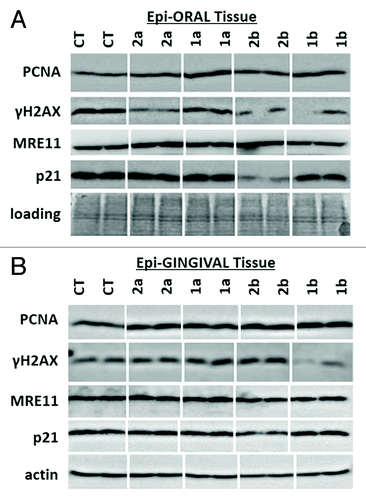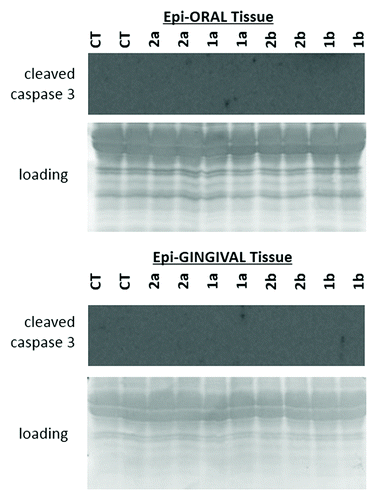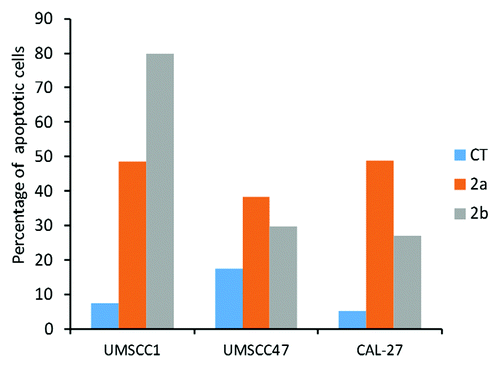Figures & data
Table 1. Summary of the gene expression in EpiOral and EpiGingival tissues upon treatment with novel antioxidant compounds 1a, 1b, 2a, and 2b
Figure 2. Expression of PCNA, γH2AX, MRE11 and p21 in EpiOral (A) and EpiGingival (B) tissues treated with 1a, 1b, 2a, and 2b antioxidants. CT, control tissues; 1a, 1b, 2a, 2b, tissues treated with antioxidants. Antioxidants: 1a, 6′-hydroxy-2′,5′,7′,8′-tetramethylchroman-2′-yl) methyl 3,4,5-trihydroxybenzoate; 1b, 6′-hydroxy-2′,5′,7′,8′-tetramethylchroman-2′-yl) methyl 3,5-dimethoxy-4-hydroxycinnamate; 2a, N-decyl-N-(3,5-dimethoxy-4-hydroxybenzyl)-3-(3,4-dihydroxyphenyl) propanamide; 2b, N-decyl-N-(3-methoxy-4-hydroxybenzyl)-3-(3,4-dihydroxyphenyl) propanamide.

Figure 3. Levels of cleaved caspase 3 in EpiOral and EpiGingival tissues treated with 1a, 1b, 2a, and 2b antioxidants.CT, control tissues; 1a, 1b, 2a, 2b, tissues treated with antioxidants. Antioxidants: 1a, 6′-hydroxy-2′,5′,7′,8′-tetramethylchroman-2′-yl) methyl 3,4,5-trihydroxybenzoate; 1b, 6′-hydroxy-2′,5′,7′,8′-tetramethylchroman-2′-yl) methyl 3,5-dimethoxy-4-hydroxycinnamate; 2a, N-decyl-N-(3,5-dimethoxy-4-hydroxybenzyl)-3-(3,4-dihydroxyphenyl) propanamide; 2b, N-decyl-N-(3-methoxy-4-hydroxybenzyl)-3-(3,4-dihydroxyphenyl) propanamide.

Figure 4. Expression of γH2AX, PCNA, MRE11, p21, and cleaved caspase 3 in CAL27, UMSCC1 and UMSCC47 oral squamous cell carcinoma lines treated with 1a, 1b, 2a, and 2b antioxidants. CT, control tissues; 1a, 1b, 2a, 2b, tissues treated with antioxidants. Antioxidants: 1a, 6′-hydroxy-2′,5′,7′,8′-tetramethylchroman-2′-yl) methyl 3,4,5-trihydroxybenzoate; 1b, 6′-hydroxy-2′,5′,7′,8′-tetramethylchroman-2′-yl) methyl 3,5-dimethoxy-4-hydroxycinnamate; 2a, N-decyl-N-(3,5-dimethoxy-4-hydroxybenzyl)-3-(3,4-dihydroxyphenyl) propanamide; 2b, N-decyl-N-(3-methoxy-4-hydroxybenzyl)-3-(3,4-dihydroxyphenyl) propanamide.

Figure 5. Induction of apoptosis by 1a, 1b, 2a, and 2b antioxidants in CAL27, UMSCC1 and UMSCC47 oral squamous cell carcinoma lines as analyzed by the Annexin V assay. CT, control tissues; 1a, 1b, 2a, 2b, tissues treated with antioxidants. Antioxidants: 1a, 6′-hydroxy-2′,5′,7′,8′-tetramethylchroman-2′-yl) methyl 3,4,5-trihydroxybenzoate; 1b, 6′-hydroxy-2′,5′,7′,8′-tetramethylchroman-2′-yl) methyl 3,5-dimethoxy-4-hydroxycinnamate; 2a, N-decyl-N-(3,5-dimethoxy-4-hydroxybenzyl)-3-(3,4-dihydroxyphenyl) propanamide; 2b, N-decyl-N-(3-methoxy-4-hydroxybenzyl)-3-(3,4-dihydroxyphenyl) propanamide.

Figure 6. Schematic representation of the MAPK pathways that is upregulated in MCF-7 cells upon treatment with compound 2b (N-decyl-N-[3-methoxy-4-hydroxybenzyl]-3-[3,4-dihydroxyphenyl] propanamide). DAVID Bioinformatic resource (http://david.abcc.ncifcrf.gov/), the KEGG Pathways.Citation42 The KEGG (Kyoto Encyclopedia of Genes and Genomes) MAPK pathway map can be found online at http://www.genome.jp/kegg/. Stars denote genes which exhibited altered expression upon antioxidant treatment.
![Figure 6. Schematic representation of the MAPK pathways that is upregulated in MCF-7 cells upon treatment with compound 2b (N-decyl-N-[3-methoxy-4-hydroxybenzyl]-3-[3,4-dihydroxyphenyl] propanamide). DAVID Bioinformatic resource (http://david.abcc.ncifcrf.gov/), the KEGG Pathways.Citation42 The KEGG (Kyoto Encyclopedia of Genes and Genomes) MAPK pathway map can be found online at http://www.genome.jp/kegg/. Stars denote genes which exhibited altered expression upon antioxidant treatment.](/cms/asset/c153f194-947a-4dcc-b9d9-60190fb33844/kcbt_a_10925935_f0006.gif)
